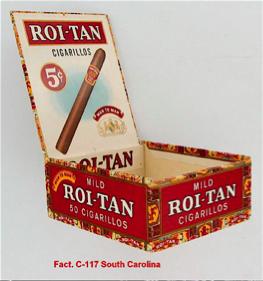
Types of Cigar Boxes
23 types you’re most likely to see
A National Cigar Museum EXCLUSIVE
(c) Tony Hyman
There are two types of cigar boxes: wood and everything else. Between 1800 and 1960 around 80% of all cigar boxes were made of wood. That amounts to somewhere around eight billion (a reasonably calculated estimate) wooden cigar boxes.
Another two billion cigar boxes were made of cardboard, tin, glass, plastic, tin foil, aluminum, pewter, brass, china, ceramics, silverplate and palm leaves.
This chapter is an overview of shapes and materials you’re most likely to encounter today. Numbers in brackets [0000] are picture catalog numbers.
2. Nailed Wood with Hardware (NWH):
1. Nailed Wood (NW):
The most common box was what box makers descriptively and unromantically call a “standard Nailed Wood box,” abbreviated NW. Other than a change in lid design in the 1870’s, Nailed Wood boxes have remained the same for 200 years: six pieces of wood, 14 nails and a muslin hinge.
Wood can be cut and nailed into an almost endless variety of sizes and shapes of box. By far the most common 20th century wooden boxes held 50 cigars packed 4 deep 13 across or 25 cigars packed 2 deep 13 across. The short row on the bottom was completed with a wooden or cardboard “block” to take the place of the missing cigars so all the rows stacked evenly.
OLD ABE from 1926 and HARVESTER from 1938 typify what box makers and collectors call NW 50/13 and NW 25/13 boxes.
The two biggest users of BN boxes were Jose Escalante (CORINA) and T.E. Brooks (BROOKS & CO.). Neither brand has collector value, though both have been used to make cigar box musical instruments. BN’s were frequently used for private labels for tobacconists, men’s clubs, restaurants, and the like.
An untrimmed box made entirely of wood that has some of the characteristics of a BN box, but not all, is called a “semi-boite nature” or SBN. For example, an SBN might be made without a collar, or have nailed corners rather than interlocked.
All cigar boxes are custom boxes to some extent because cigars were measured by 1/32 of an inch, and the box ordered had to fit the cigars made. But when the design of the box changes to something ‘non standard’ it’s usually called an SBN.
A great many modern cigar boxes are SBNs.
Nailed Wood boxes are typically “trimmed.”
When a customer tells a box maker he wants a “trimmed box” he is saying shorthand for :
“The entire box is to be edged with inch wide paper strips, the inside of the lid has a paper label, the sides and bottom are lined with paper, and various tags, flaps, banners and price stickers are attached as needed. The outside top of the lid is to be branded or labeled, the front may be imprinted with the name given that size and shape of cigar, and all proper legal notices are attached or printed on the box.”
You can see why people shortened it to “trimmed.”
Most trim was pasted on by the box maker. The cigar factory also added trim to boxes, putting on the outer label, color mark (on one end), nail tag, and revenue stamp. Sizes, shapes, colors and placement of trim has changed only slightly over time.
To learn about trim, be patient. Exhibits are planned about label types, nomenclature and how and where they were ordered, designed, manufactured and applied.
Boxmakers often integrated die cuts into the designs of NWH boxes. You will find NWH boxes with Standard inner labels, but that’s not typical. Box Liners are often blue, pink, or grey paper instead of the more typical cream. NWH boxes were most popular 1885 to 1910, but are not uncommon later. Later ones are inevitably very plain. NWHs remained around until the 1930s (and can be ordered today).
3. Boite Nature (BN):
4. Semi-boite Nature (SBN):
5. Cuban Chests and Cabinets:
During the Victorian age prominent families of Europe and America, including the Hapsburgs, Morgans and Vanderbilts, ordered their cigars from Cuba by the tens of thousands, often packed in fine cabinetry. Boxes were generally inlaid, monogrammed, or labeled with the family crest. Few have survived. This fine inlaid chest held HOYO de MONTERREY cigars made for General Jose Miguel Gomez, the 2nd President of Cuba.
6. “Your Choice”
A distinct style of cigar box found in both NW and NWH boxes is called a “Your Choice” because it offered smokers an opportunity to ‘vote’ for an actress (ala American Idol) or a political candidate. Other Your Choice boxes offered different colors or strengths of cigars. They date as far back as the 1870’s, and were most popular before 1920. [4272]
7. Assortments:
“NWC 13/13 assortment 4” is the short way of saying this is a “nailed wood box with a clasp that held 13 cigars all of them in the top row which is divided into four different size sections.”
![8. Novelties:

First permitted in 1878, novelty boxes are boxes out of the ordinary, boxes you might not recognize as cigar boxes. The most common cigar box novelties are books, trunks and log cabins. [3456]
Other shapes include boxes shaped like bottles, barrels, mail boxes, cheese boxes, deed boxes, vehicles, radios, billiard tables, firecrackers and giant cigars.

Novelties are often intended to be used in some practical way when emptied. Game boxes reusable to play checkers, backgammon or cribbage were popular as were boxes that could be reused as toys, banks, attache cases, letter files, desk accessories, etc.
100 Dutch cigars were packed in this child’s truck.
I don’t know when. Do you? [3437]
To see a selection of Novelty packaging click <here>](Box_type_overview%20_files/shapeimage_2.png)

14. Tin Cans:
bb
The use of round tin 50/up slip top cans appears to date from the early 20th century, about the time BUSTER BROWN was a popular comic in the newspapers. Tin cans were especially popular 1910 to 1940 after depletion of Cuban and Central American cedar and mahogany forests made cigar box wood more expensive.
Almost all tin cans were “tin 50/up” and “tin 25/up” with the other 1% used for cans holding 10, 12 and 100 cigars. Most 50/up cans are round, though square shaped 50/ups are also found. Stogie cans are usually about an inch taller than cigar cans. P.S.: Stogies and cigars are not the same thing.
Five rows of five cigars was so logical a package that tin 25/up cans were more often square than round, though both are seen. Ad copy on both 25 and 50/ups was applied with paper labels or with the graphics lithographed directly onto the tin, the latter usually the more collectible. A display stand or glass display lid is a major plus. This display dates from the 1920’s.
Upright cans were also made oval and rectangular and with hinged, slip top and vacuum lids. Pictured here are a 10/up oval slip top, 12/up rectangular slip top and a 25/up hinged rectangle, all litho on tin. Of these, the ELIMINATOR is the most rare brand and box shape.
STATE JOURNAL is a 25/up hinged rectangle (some call oblong) with paper label along side a 50/up hinged oval. These tins date from 1910 to 1930. Post WWII use of tin declined in the face of cheaper cardboard boxes. DUTCH MASTERS (not pictured) is one of the few brands to make extensive use of tin after 1960.
No matter how old a tin can, scratches, rust, or missing lids are serious defects. There is no such thing as “good for its age.”
9. Wooden Novelties of the Depression:
During the 1930’s, a time when few could afford to buy a whole box of cigars, many cigarmen turned to dual purpose novelty packaging, offering a bonus to the buyer: cigars for him; a jewelry box for her. More than 100 different designs are known in wood and metal, but variations of these red cedar “pirate’s chests” are the most common.
Machine-made cigars combined with the Great Depression of the 1930’s to drive out of business the smaller makers of hand made cigars selling from 10¢ to 25¢. Eight of every ten cigars sold during the 1930’s were machine made and cost 5¢ or less. Fancy wooden boxes holding nickel cigars were offered in an amazing array of styles. [4377]
10. Tin boxes:
The tax law of 1870 allowed cigar boxes to be made of tin for the first time. Early boxes are hand soldered and have paper labels, though a few exquisitely printed boxes have survived from the 1880’s & 90’s. Printed tin before 1900 is scarce because ink and manufacturing techniques were in their infancy so waste was high and tin boxes fairly expensive. Multi-color boxes were being successfully printed, but monochromatic sports-themed gems by Brooklyn’s Vogel Litho. are among collector favorites. Over time, early tin boxes were susceptible to damage resulting from rust and extreme heat or cold causing cracks in the ink. [2907]
Compared to Nailed Wood boxes, tin cans and boxes tend to have simplistic designs, the majority printed by photo-mechanical processes in four or fewer colors. But spectacular exceptions exist, among them JULIA MARLOWE, a distinctive pre WWI Canadian cigar box honoring her performance in Romeo and Juliet on Broadway. [2923] A Curator’s Favorite.
The all time largest user of tin containers was Pennsylvania’s Bayuk Bros. for their nationally popular PHILLIES. During the 1920’s and 30’s four different 50/13 styles with dozens of different inside Banners made an appearance as did an equal number of 25/ups in tin. The gradual name and advertising shift from being sold as PHILADELPHIA PERFECTOS to being marketed as PHILLIES is documented in their tin boxes. [3157]
21. Plastic Boxes:
Most plastic boxes date after World War II, though a few earlier ones exist. Only a few brands used plastic extensively, especially EL PRODUCTO and CORINA.
During the Early Modern Age of the 1960’s and 70’s MARK IV and HOUSE OF WINDSOR used black and brown boxes to indicate the color of the cigars inside. Plastic boxes are brittle, tend to have weak hinges and are very subject to sun damage. [3506]
11. Pocket tins:
Pocket tins holding 10 cigars in two rows of 5 came on the market immediately after the Tax laws of 1910 permitted “large” cigars to be packed in 10’s. Pocket tins have slip tops not hinges. Between 4” and 5” long they usually have the ad-copy horizontal like this one.
Emerson was a fairly popular brand, lasting more than 40 years. Cigars made by Lewis Cigar Co. in Illinois during the 1920’s. [2965]
12. Flat tens:
The small 3± inch square hinged “tin 10/10” (popularly called a “flat ten”) was used for cigarettes and cigarette size cigars (weighing under 3 lbs. per 1,000). Small flat tens appeared on the market right after boxes of 10 small cigars were made legal in 1897. Many of the factories that specialized in these diminutive smokes were located in NYC, Baltimore and Virginia. Before World War One, most competitors were either purchased or run out of business by the Tobacco Trust. [2988]
On breakup of the Trust in 1911, P. Lorillard obtained BETWEEN THE ACTS, a brand of small cigars with two decades worth of brand recognition. After WWI Lorillard packed BTA in flat 10’s, and for 30 years BETWEEN THE ACTS was one of the biggest selling cigars sold in tin. A surprising two dozen or more other brands of small cigars were still being packed in similar tins as late as the 1950’s. [2991]
![13. Lunchboxes:

Smoking tobacco manufacturers were more likely to pack in lunchboxes than were cigar makers, but a handful of interesting cigar lunchboxes were made.
Retailers didn’t much like them because they were hard to stack. This WHITE HEN was made in 1909 and uses paper labels. [7906]
Most lunchboxes, including the popular CINCO and GREEN TURTLE boxes, are printed directly on the tin. [2950]
No matter what tobacco was packed in it, lunchboxes were popular with school kids and their fathers. Yes, they really were used as lunchboxes when emptied.
](Box_type_overview%20_files/shapeimage_3.png)
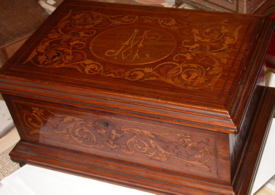
19. Five Packs:
Packages of 5 regular size cigars were made legal in 1910. Cardboard quickly became the material of choice. There are many variations of 5/5 cardboard packs. Most, like this, are printed and die cut, then folded and glued along one edge and shipped flat from the printer. The design looks right out of the 1940’s but is actually from the 1970’s. [3571]
Is FORE really a good brand name for a box of FIVE cigars? “Gimme fore cigars” does not flow trippingly on the tongue when you really want five.
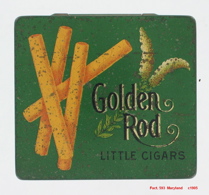
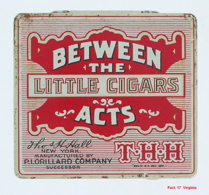
15. Tin Novelties:
Since the 1890’s, tin and other metals have been used to create novelty cigar packaging. By 1910, tin lunch boxes, cash boxes, deed boxes and other “reusables” were being made from tin. A tin beer stein cigar can appeared in 1914.
Like all tin, novelty boxes must be in fine condition to be of interest.
16. Metal novelties of the 1930’s:
These boxes almost always have mirrors inside the lid. Inevitably the Tax Class notice reports the contents selling at 5¢ or less.
17. Aluminum and other Metals:
Aluminum, brass, foil and silver plate have all been used to manufacture retail cigar boxes or packages.
Plate is in evidence in the 1890’s, as is aluminum, tho it
is likely that plate was used in the mid 1800’s, aluminum next in the 1890’s. Brass boxes or cans haven’t been reported before the 1930’s.
F.R. Rice, a St. Louis distributor and cigar maker was a packaging innovator, using aluminum, glass, and other materials as distinctive packages during the Golden Age before 1915. [2518]
This lovely brass box was used to hold 100/17 cigars in the 1930’s, but not all boxes that look like this are cigar boxes. This was a stock item, sold by the box maker to retailers and packers of other products. Look for the ID printed on the wooden bottom. [3422]
18. Cardboard boxes:
Cardboard has been used for cigar boxes in the U.S. and Cuba since the 1850’s when the first machine-made cardboard was introduced. The cheaper more uniform cardboard became a hit with retailers looking for light weight packaging for hats, shoes and other products, including cheap cigars. Cardboard cans and shoe boxes were used for cigars first, then came boxes for small cigarette size cigars in the 1880’s. Around 1900, a few cigars were sold in thick cardboard 50/13 boxes nailed together exactly like their NWW counter-parts.
It wasn’t until the late 1930’s that a machine capable of producing a compete finished cardboard 50/13 cigar box was introduced. World War Two delayed implemen-tation, but by the late 1950’s two-thirds of domestic cigars appear to have been packed in cardboard.
Round, square and rectangular upright Cans were made of cardboard since thee 1850’s. This octagonal can from 1910 is unusual. Stogie makers were especially likely to use cardboard in the 1800’s as a cost-cutting move. [2858]
The variety of sizes and shapes of cardboard box is amazing.
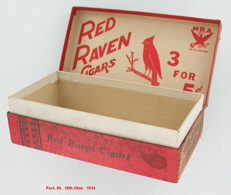
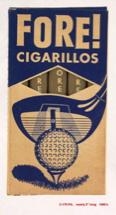
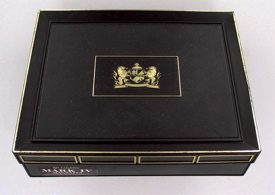
22. Glass Boxes and Jars:
Glass has been used to pack Cuban cigars as early as the 1850’s, and possibly earlier, but the oldest mentions are of glass “chests” rather than jars. Ads for companies making glass jars for packing cigars are found as early as 1860 in the United States. Jars were particularly popular 1910 to 1940.
Jars are rarely found with all their labels, government warnings and revenue stamps intact, even more rarely are they seen full.
LA PALINA was the most popular cigar packed in glass jars, both round and 16 sided. The latter was introduced after retailers complained of dropping the heavy slick round jars through glass countertops. [2821]
ID’s were required to be molded into the glass, so there’s seldom any doubt whether you’re holding a cigar jar or not. This fancy pressed glass cigar jar used by F.R. Rice Mercantile Co. of St. Louis has the ID hidden in one of the rosettes centered around the jar. [2810]
Wooden and tin boxes were also made with glass tops and / or fronts.
To see a selection of jars and boxes
23. Uprights:
How many ways can you pack cigars on end?
The surprisingly large number is testimonial to man’s ingenuity. The nine you see in the picture give only a hint of the shapes and materials.
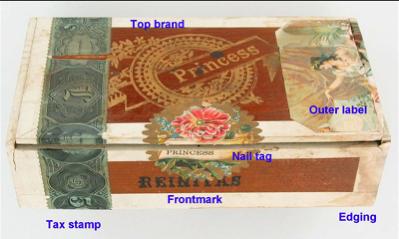
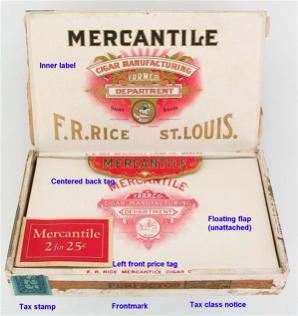

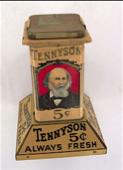
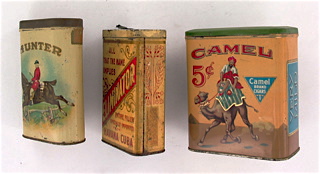
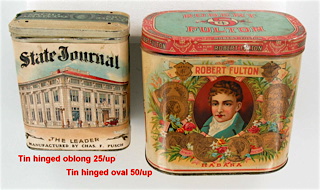


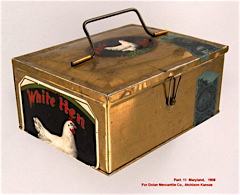

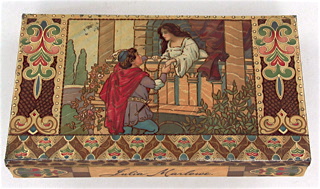


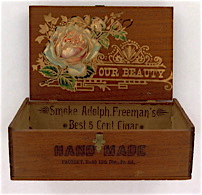
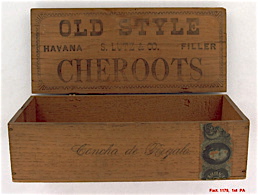
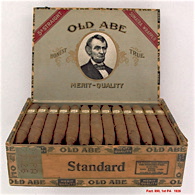

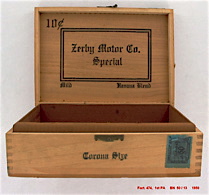
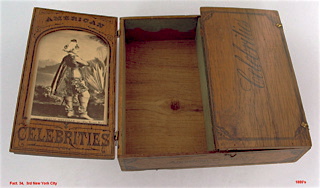
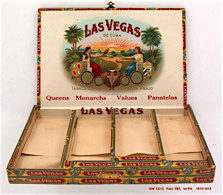

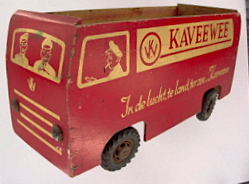
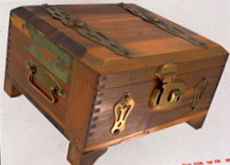
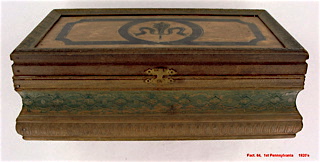
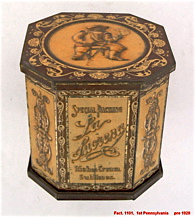

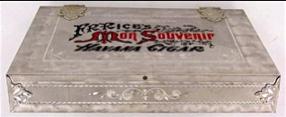
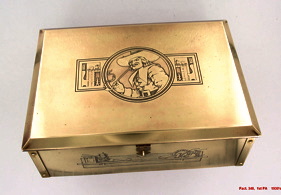

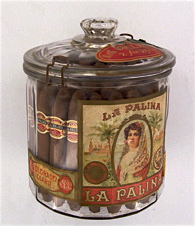
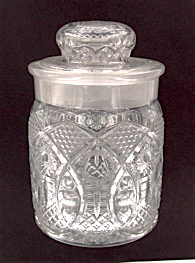
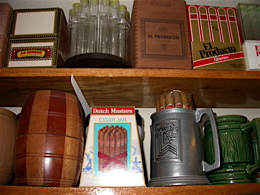
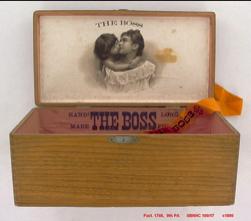
20. Cigarillo Boxes
Though they seem to have appeared in the 1940’s,
the pencil-thick machine rolled cigarillo didn’t have much market impact until General Cigar’s huge and successful 1950’s campaign to market their ROBT. BURNS version. Nearly every national cigar brand was forced to follow suit. Cigarillo boxes are inevitably cardboard roughly 4” x 5” and vary little in size from brand to brand. Prices range from 3/10¢ to a nickel. The various brands will use other diminutive frontmarks including Petites, Juniors, Babies, Miniatures, Intermissions, Cadets, Ponies, etc.
